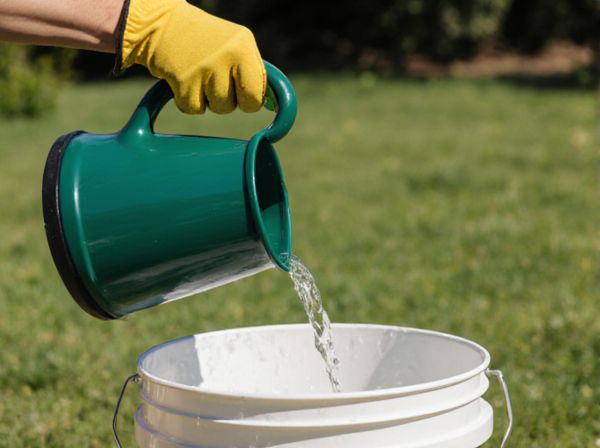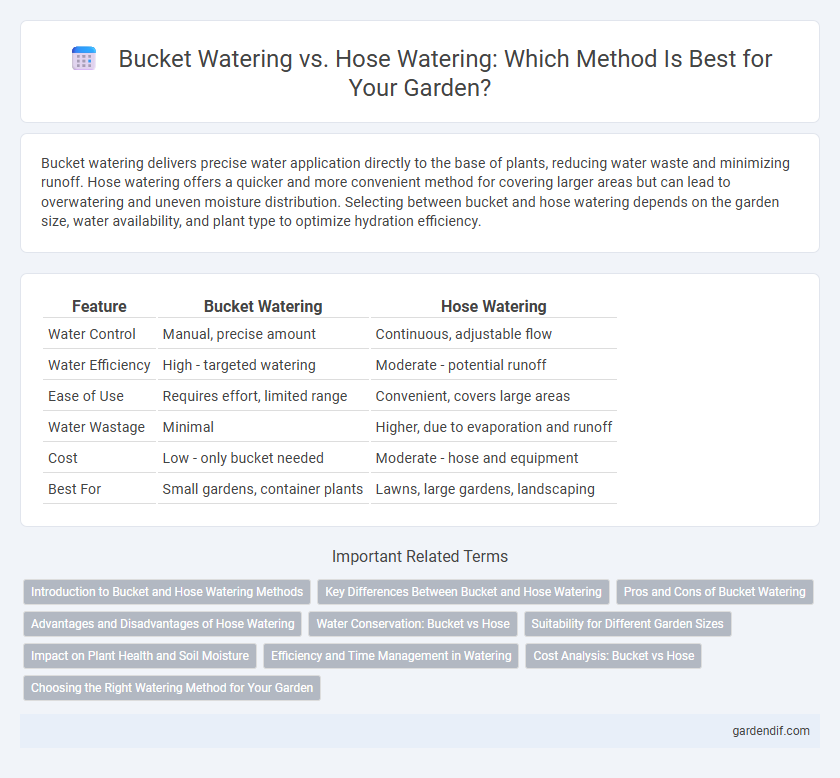
Bucket watering vs Hose watering Illustration
Bucket watering delivers precise water application directly to the base of plants, reducing water waste and minimizing runoff. Hose watering offers a quicker and more convenient method for covering larger areas but can lead to overwatering and uneven moisture distribution. Selecting between bucket and hose watering depends on the garden size, water availability, and plant type to optimize hydration efficiency.
Table of Comparison
| Feature | Bucket Watering | Hose Watering |
|---|---|---|
| Water Control | Manual, precise amount | Continuous, adjustable flow |
| Water Efficiency | High - targeted watering | Moderate - potential runoff |
| Ease of Use | Requires effort, limited range | Convenient, covers large areas |
| Water Wastage | Minimal | Higher, due to evaporation and runoff |
| Cost | Low - only bucket needed | Moderate - hose and equipment |
| Best For | Small gardens, container plants | Lawns, large gardens, landscaping |
Introduction to Bucket and Hose Watering Methods
Bucket watering involves manually filling a container and pouring water directly onto plants, offering precise control over water distribution and minimizing waste. Hose watering uses a flexible tube connected to a water source, enabling continuous and efficient irrigation over larger areas with adjustable flow rates. Both methods have distinct advantages depending on garden size, plant type, and water conservation goals.
Key Differences Between Bucket and Hose Watering
Bucket watering provides precise control over water application, reducing wastage and targeting plant roots directly, which is ideal for container plants and small gardens. Hose watering offers quicker coverage for larger areas but risks overwatering and runoff due to less control over water volume and pressure. Both methods vary significantly in efficiency, water conservation, and suitability depending on garden size and plant type.
Pros and Cons of Bucket Watering
Bucket watering offers precise water control, minimizing waste and reducing runoff compared to hose watering. It promotes deep root hydration by allowing targeted placement, but it can be labor-intensive and time-consuming for larger gardens. While bucket watering conserves water and supports plant health, its manual nature limits efficiency in extensive or hard-to-reach areas.
Advantages and Disadvantages of Hose Watering
Hose watering offers the advantage of continuous water flow, enabling efficient irrigation of large garden areas and reducing manual effort compared to bucket watering. However, hose watering can lead to water wastage if not carefully controlled, and uneven water distribution may cause overwatering or underwatering in specific plant zones. Maintenance issues such as leaks or kinks in the hose can also disrupt consistent watering schedules and increase water consumption.
Water Conservation: Bucket vs Hose
Bucket watering conserves water more effectively by allowing precise control over the amount used, minimizing runoff and evaporation. Hose watering often leads to excessive water use due to continuous flow and overspray, increasing wastage. Utilizing a bucket for watering reduces overall water consumption, making it an eco-friendly choice for sustainable gardening.
Suitability for Different Garden Sizes
Bucket watering is ideal for small to medium-sized gardens where precise water control is needed, reducing water wastage and allowing targeted nourishment to plants. Hose watering suits larger gardens or lawns, providing quick and efficient coverage with adjustable flow rates for diverse plant types. Choosing between bucket and hose watering depends on garden size, plant variety, and water conservation priorities.
Impact on Plant Health and Soil Moisture
Bucket watering delivers precise amounts of water directly to the plant roots, reducing runoff and promoting deeper soil moisture retention essential for healthy root development. Hose watering can lead to uneven water distribution and surface runoff, potentially causing soil erosion and shallow root growth that weakens plant health. Consistent moisture levels maintained by bucket watering enhance nutrient absorption and reduce the risk of fungal diseases linked to overwatering or waterlogging from hose irrigation.
Efficiency and Time Management in Watering
Bucket watering conserves water by delivering precise amounts directly to plant roots, reducing waste and runoff, making it ideal for targeted irrigation in small gardens. Hose watering allows faster coverage of larger areas but often results in water loss through evaporation and overwatering, reducing overall efficiency. Time management favors hose watering for extensive spaces, while bucket watering excels in optimizing water use and minimizing resource waste in concentrated zones.
Cost Analysis: Bucket vs Hose
Bucket watering incurs minimal initial costs, with only the price of the bucket required, making it highly economical for small-scale use. Hose watering involves higher upfront expenses due to purchasing the hose and possibly a sprinkler system, but it offers greater efficiency and time savings in large gardens. Over time, hose watering can reduce labor costs, though water usage should be monitored to avoid high utility bills.
Choosing the Right Watering Method for Your Garden
Bucket watering delivers precise amounts of water directly to plant roots, reducing water waste and soil erosion, making it ideal for small gardens or container plants. Hose watering offers faster coverage for larger garden areas, but requires careful control to prevent overwatering and runoff. Selecting the appropriate method depends on garden size, plant types, and water conservation goals to ensure optimal plant health and resource efficiency.
Bucket watering vs Hose watering Infographic

 gardendif.com
gardendif.com